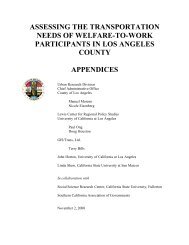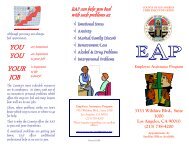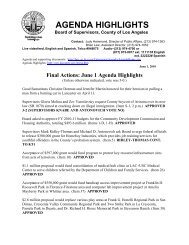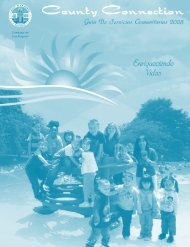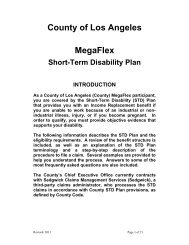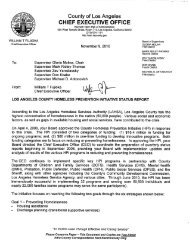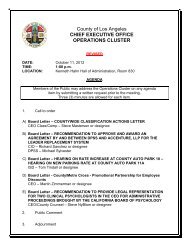- Page 1 and 2: Board of Supervisors Gloria Molina
- Page 3 and 4: County of Los Angeles Board of Supe
- Page 5 and 6: The Honorable Board of Supervisors
- Page 7 and 8: The Honorable Board of Supervisors
- Page 9 and 10: The Honorable Board of Supervisors
- Page 11 and 12: The Honorable Board of Supervisors
- Page 13 and 14: The Honorable Board of Supervisors
- Page 15 and 16: The Honorable Board of Supervisors
- Page 17 and 18: The Honorable Board of Supervisors
- Page 19 and 20: The Honorable Board of Supervisors
- Page 21 and 22: Table of Contents General Informati
- Page 23 and 24: General Information
- Page 25 and 26: RECOMMENDED BUDGET FINANCIAL SUMMAR
- Page 27 and 28: 35,000 30,000 25,000 20,000 15,000
- Page 29 and 30: FUND ORGANIZATION NAME RECOMMENDED
- Page 31 and 32: SHERIFF INMATE POPULATION The Sheri
- Page 33: CALIFORNIA WORK OPPORTUNITIES AND R
- Page 37 and 38: COUNTY OF LOS ANGELES LEGEND APPOIN
- Page 39 and 40: Affirmative Action Compliance Offic
- Page 41 and 42: AFFIRMATIVE ACTION COMPLIANCE BUDGE
- Page 43 and 44: Organizational Chart See Human Reso
- Page 45 and 46: Changes From 2010-11 Budget Gross A
- Page 47 and 48: TOPE AGRICULTURAL COMMISSIONER - WE
- Page 49 and 50: TOPE AGRICULTURAL COMMISSIONER - WE
- Page 51 and 52: Alternate Public Defender Janice Y.
- Page 53 and 54: ALTERNATE PUBLIC DEFENDER BUDGET DE
- Page 55 and 56: LAW OFFICES OF THE ALTERNATE PUBLIC
- Page 57 and 58: Critical/Strategic Planning Initiat
- Page 59 and 60: Unmet Needs ANIMAL CARE AND CONTROL
- Page 61 and 62: ANIMAL CARE AND CONTROL BUDGET DETA
- Page 63 and 64: Arts Commission Laura Zucker, Execu
- Page 65 and 66: ARTS COMMISSION BUDGET DETAIL TOPE
- Page 67 and 68: Assessor John R. Noguez, Assessor A
- Page 69 and 70: 8. One-Time Funding: Reflects the d
- Page 71 and 72: ASSESSOR BUDGET DETAIL (Continued)
- Page 73 and 74: Auditor-Controller Wendy L. Watanab
- Page 75 and 76: 3. Capital Assets: Reflects the eli
- Page 77 and 78: AUDITOR-CONTROLLER BUDGET DETAIL CL
- Page 79 and 80: Auditor-Controller - Integrated App
- Page 81 and 82: DEPARTMENT OF AUDITOR-CONTROLLER We
- Page 83 and 84: Changes From 2010-11 Budget Gross A
- Page 85 and 86:
BEACHES AND HARBORS BUDGET DETAIL C
- Page 87 and 88:
Beaches and Harbors - Beach Budget
- Page 89 and 90:
Board of Supervisors Sachi A. Hamai
- Page 91 and 92:
9. Community Programs: Reflects the
- Page 93 and 94:
BOARD OF SUPERVISORS BUDGET DETAIL
- Page 95 and 96:
Capital Projects/Refurbishments Cap
- Page 97 and 98:
Changes from 2010-11 Budget Gross A
- Page 99 and 100:
13. Probation: Probation’s capita
- Page 101 and 102:
Chief Executive Officer William T F
- Page 103 and 104:
CHIEF EXECUTIVE OFFICER BUDGET DETA
- Page 105 and 106:
CHIEF EXECUTIVE OFFICER WILLIAM T F
- Page 107 and 108:
Changes From 2010-11 Budget Unmet N
- Page 109 and 110:
CHIEF INFORMATION OFFICE BUDGET DET
- Page 111 and 112:
Child Support Services Steven J. Go
- Page 113 and 114:
Other Changes 1. Trust Fund Adjustm
- Page 115 and 116:
TOPE CHILD SUPPORT SERVICES DEPARTM
- Page 117 and 118:
Children and Family Services Antoni
- Page 119 and 120:
■ Collaboration with the Departme
- Page 121 and 122:
3. Deferred Compensation: Reflects
- Page 123 and 124:
TOPE CHILDREN AND FAMILY SERVICES -
- Page 125 and 126:
Children and Family Services - Assi
- Page 127 and 128:
TOPE CHILDREN AND FAMILY SERVICES -
- Page 129 and 130:
KinGAP Budget Summary DCFS - KINGAP
- Page 131 and 132:
Community and Senior Services Cynth
- Page 133 and 134:
Changes From 2010-11 Budget Gross A
- Page 135 and 136:
Unmet Needs COMMUNITY AND SENIOR SE
- Page 137 and 138:
TOPE COMMUNITY AND SENIOR SERVICES
- Page 139 and 140:
Curtailments 1. Employment and Trai
- Page 141 and 142:
Workforce Investment Act Budget Sum
- Page 143 and 144:
Consumer Affairs Rigoberto Reyes, A
- Page 145 and 146:
6. Miscellaneous: Reflects minister
- Page 147 and 148:
CONSUMER AFFAIRS BUDGET DETAIL (Con
- Page 149 and 150:
Coroner Anthony T. Hernandez, Direc
- Page 151 and 152:
8. Labor-Management Savings: Reflec
- Page 153 and 154:
CORONER BUDGET DETAIL (Continued) T
- Page 155 and 156:
County Counsel Andrea Sheridan Ordi
- Page 157 and 158:
6. Unavoidable Costs: Reflects an a
- Page 159 and 160:
COUNTY COUNSEL BUDGET DETAIL (Conti
- Page 161 and 162:
District Attorney Steve Cooley, Dis
- Page 163 and 164:
3. Retiree Health Insurance: Reflec
- Page 165 and 166:
DISTRICT ATTORNEY BUDGET DETAIL CLA
- Page 167 and 168:
DISTRICT ATTORNEY BUDGET DETAIL (Co
- Page 169 and 170:
Emergency Preparedness and Response
- Page 171 and 172:
Employee Benefits Employee Benefits
- Page 173 and 174:
FY 2011-12 Recommended Employee Emp
- Page 175 and 176:
Changes From 2010-11 Budget Unmet N
- Page 177 and 178:
Financing Elements Financing Elemen
- Page 179 and 180:
Fire Daryl L. Osby, Fire Chief, For
- Page 181 and 182:
Unmet Needs Financing Uses ($) FIRE
- Page 183 and 184:
TOPE FIRE DEPARTMENT BUDGET DETAIL
- Page 185 and 186:
TOPE FIRE DEPARTMENT BUDGET DETAIL
- Page 187 and 188:
Fire - Clearing Account Budget Unit
- Page 189 and 190:
Fire - Operations Budget Unit Budge
- Page 191 and 192:
Fire - Lifeguards Budget Summary FI
- Page 193 and 194:
LOS ANGELES COUNTY FIRE DEPARTMENT
- Page 195 and 196:
Changes From 2010-11 Budget Unmet N
- Page 197 and 198:
GRAND JURY Juror Services Division
- Page 199 and 200:
2011-12 Budget Message DHS continue
- Page 201 and 202:
4. Healthcare Interpreters: Reflect
- Page 203 and 204:
12. Other Program Changes: Reflects
- Page 205 and 206:
HEALTH SERVICES SUMMARY BUDGET DETA
- Page 207 and 208:
HEALTH SERVICES SUMMARY BUDGET DETA
- Page 209 and 210:
Health Services Administration Budg
- Page 211 and 212:
TOPE HEALTH SERVICES - HEALTH SERVI
- Page 213 and 214:
TOPE HEALTH SERVICES - HEALTH SERVI
- Page 215 and 216:
■ Adjustments for approved classi
- Page 217 and 218:
TOPE HEALTH SERVICES - JUVENILE COU
- Page 219 and 220:
Office of Managed Care Budget Summa
- Page 221 and 222:
TOPE HEALTH SERVICES - OFFICE OF MA
- Page 223 and 224:
Contributions to Hospital Enterpris
- Page 225 and 226:
Hospital Enterprise Fund - LAC+USC
- Page 227 and 228:
LAC+USC HEALTHCARE NETWORK BUDGET D
- Page 229 and 230:
TOPE LAC+USC HEALTHCARE NETWORK BUD
- Page 231 and 232:
Hospital Enterprise Fund - MetroCar
- Page 233 and 234:
METROCARE NETWORK ENTERPRISE FUND B
- Page 235 and 236:
TOPE METROCARE NETWORK ENTERPRISE F
- Page 237 and 238:
MARTIN LUTHER KING, JR.-MULTI-AMBUL
- Page 239 and 240:
SOUTHWEST NETWORK BUDGET DETAIL CLA
- Page 241 and 242:
SOUTHWEST NETWORK BUDGET DETAIL (Co
- Page 243 and 244:
■ An increase in funding for proj
- Page 245 and 246:
TOPE RANCHO LOS AMIGOS NATIONAL REH
- Page 247 and 248:
Hospital Enterprise Fund - ValleyCa
- Page 249 and 250:
VALLEYCARE NETWORK BUDGET DETAIL CL
- Page 251 and 252:
VALLEYCARE NETWORK BUDGET DETAIL (C
- Page 253 and 254:
HIGH DESERT HEALTH SYSTEM / MULTI-S
- Page 255 and 256:
Department of Health Services Mitch
- Page 257 and 258:
Health Services - Juvenile Court He
- Page 259 and 260:
Health Services - LAC+USC Healthcar
- Page 261 and 262:
Health Services - Rancho Los Amigos
- Page 263 and 264:
Homeless and Housing Program Homele
- Page 265 and 266:
HOMELESS AND HOUSING PROGRAM BUDGET
- Page 267 and 268:
Changes From 2010-11 Budget Gross A
- Page 269 and 270:
HUMAN RESOURCES BUDGET DETAIL CLASS
- Page 271 and 272:
Lisa M. Garrett, Director of Person
- Page 273 and 274:
INFORMATION SYSTEMS ADVISORY BODY B
- Page 275 and 276:
INFORMATION SYSTEMS ADVISORY BODY (
- Page 277 and 278:
■ Complete the implementation of
- Page 279 and 280:
4. Deferred Compensation: Reflects
- Page 281 and 282:
INTERNAL SERVICES BUDGET DETAIL (Co
- Page 283 and 284:
TOPE INTERNAL SERVICES - CUSTOMER D
- Page 285 and 286:
Judgments and Damages/Insurance Jud
- Page 287 and 288:
Insurance Budget Summary INSURANCE
- Page 289 and 290:
LA PLAZA DE CULTURA Y ARTES BUDGET
- Page 291 and 292:
Changes From 2010-11 Budget Gross A
- Page 293 and 294:
Mental Health Marvin J. Southard, D
- Page 295 and 296:
Changes From 2010-11 Budget Gross A
- Page 297 and 298:
4. Homeless Services: Reflects addi
- Page 299 and 300:
MENTAL HEALTH BUDGET DETAIL CLASSIF
- Page 301 and 302:
DEPARTMENT OF MENTAL HEALTH Marvin
- Page 303 and 304:
■ Work with the California Depart
- Page 305 and 306:
TOPE MILITARY AND VETERANS AFFAIRS
- Page 307 and 308:
Museum of Art Michael Govan, Presid
- Page 309 and 310:
MUSEUM OF ART BUDGET DETAIL CLASSIF
- Page 311 and 312:
Museum of Art Michael Govan, Presid
- Page 313 and 314:
Changes From 2010-11 Budget Unmet N
- Page 315 and 316:
TOPE MUSEUM OF NATURAL HISTORY BUDG
- Page 317 and 318:
The Music Center Stephen D. Rountre
- Page 319 and 320:
MUSIC CENTER BUDGET DETAIL TOPE THE
- Page 321 and 322:
Nondepartmental Special Accounts No
- Page 323 and 324:
OFFICE OF PUBLIC SAFETY BUDGET DETA
- Page 325 and 326:
Organizational Chart See Sheriff’
- Page 327 and 328:
Changes From 2010-11 Budget Gross A
- Page 329 and 330:
PARKS AND RECREATION BUDGET DETAIL
- Page 331 and 332:
PARKS AND RECREATION BUDGET DETAIL
- Page 333 and 334:
Probation Donald H. Blevins, Chief
- Page 335 and 336:
5. Labor-Management Savings: Reflec
- Page 337 and 338:
PROBATION BUDGET DETAIL (Continued)
- Page 339 and 340:
Probation - Care of Juvenile Court
- Page 341 and 342:
Probation - Support Services Budget
- Page 343 and 344:
LOS ANGELES COUNTY PROBATION DEPART
- Page 345 and 346:
Changes From 2010-11 Budget Gross A
- Page 347 and 348:
Sheriff Reflects the transfer of $2
- Page 349 and 350:
■ Develop and implement a model t
- Page 351 and 352:
PUBLIC DEFENDER BUDGET DETAIL CLASS
- Page 353 and 354:
PUBLIC DEFENDER 2011-12 Recommended
- Page 355 and 356:
The 2011-12 Recommended Budget incl
- Page 357 and 358:
Other Changes 1. Salaries and Emplo
- Page 359 and 360:
PUBLIC HEALTH GENERAL FUND BUDGET D
- Page 361 and 362:
PUBLIC HEALTH GENERAL FUND BUDGET D
- Page 363 and 364:
TOPE PUBLIC HEALTH - PUBLIC HEALTH
- Page 365 and 366:
TOPE PUBLIC HEALTH - PUBLIC HEALTH
- Page 367 and 368:
TOPE PUBLIC HEALTH - OFFICE OF AIDS
- Page 369 and 370:
Antelope Valley Rehabilitation Cent
- Page 371 and 372:
TOPE PUBLIC HEALTH - ANTELOPE VALLE
- Page 373 and 374:
TOPE PUBLIC HEALTH - CHILDREN'S MED
- Page 375 and 376:
Substance Abuse Prevention and Cont
- Page 377 and 378:
TOPE PUBLIC HEALTH - SUBSTANCE ABUS
- Page 379 and 380:
Public Health - Public Health Progr
- Page 381 and 382:
Public Health - Antelope Valley Reh
- Page 383 and 384:
Public Health - Substance Abuse Pre
- Page 385 and 386:
customer services; and design/redes
- Page 387 and 388:
PUBLIC LIBRARY BUDGET DETAIL TOPE P
- Page 389 and 390:
PUBLIC LIBRARY BUDGET DETAIL (Conti
- Page 391 and 392:
Public Social Services Philip L. Br
- Page 393 and 394:
participants and customers. This au
- Page 395 and 396:
2. IHSS Anti-Fraud Plan: Reflects a
- Page 397 and 398:
TOPE PUBLIC SOCIAL SERVICES - ADMIN
- Page 399 and 400:
Public Social Services - Assistance
- Page 401 and 402:
20. CSBG - ARRA: Reflects decreased
- Page 403 and 404:
California Work Opportunities and R
- Page 405 and 406:
In-Home Supportive Services Budget
- Page 407 and 408:
Public Works Gail Farber, Director
- Page 409 and 410:
■ The Public Works - General Fund
- Page 411 and 412:
PUBLIC WORKS - GENERAL FUND BUDGET
- Page 413 and 414:
Public Works - Flood Control Distri
- Page 415 and 416:
TOPE PUBLIC WORKS - FLOOD CONTROL D
- Page 417 and 418:
TOPE PUBLIC WORKS - FLOOD CONTROL D
- Page 419 and 420:
Public Works - Road Fund Budget Sum
- Page 421 and 422:
PUBLIC WORKS - ROAD FUND BUDGET DET
- Page 423 and 424:
PUBLIC WORKS - ROAD FUND BUDGET DET
- Page 425 and 426:
Critical/Strategic Planning Initiat
- Page 427 and 428:
PUBLIC WORKS - INTERNAL SERVICE FUN
- Page 429 and 430:
TOPE PUBLIC WORKS - INTERNAL SERVIC
- Page 431 and 432:
Regional Planning Richard J. Bruckn
- Page 433 and 434:
4. Workers’ Compensation: Reflect
- Page 435 and 436:
REGIONAL PLANNING BUDGET DETAIL (Co
- Page 437 and 438:
Registrar-Recorder/County Clerk Dea
- Page 439 and 440:
4. Retirement Debt Services: Reflec
- Page 441 and 442:
TOPE REGISTRAR-RECORDER AND COUNTY
- Page 443 and 444:
Rent Expense Rent Expense Budget Su
- Page 445 and 446:
Sheriff Leroy D. Baca, Sheriff Sher
- Page 447 and 448:
7. Sexual Assault Kit Backlog: Refl
- Page 449 and 450:
Unmet Needs SHERIFF Budget Summarie
- Page 451 and 452:
SHERIFF BUDGET DETAIL (Continued) T
- Page 453 and 454:
Sheriff - Administration Budget Sum
- Page 455 and 456:
Sheriff - Custody Budget Summary SH
- Page 457 and 458:
SHERIFF’S DEPARTMENT LEROY D. BAC
- Page 459 and 460:
Changes From 2010-11 Budget Gross A
- Page 461 and 462:
Treasurer and Tax Collector Mark J.
- Page 463 and 464:
6. Labor-Management Savings: Reflec
- Page 465 and 466:
TOPE TREASURER AND TAX COLLECTOR BU
- Page 467 and 468:
Trial Court Operations Trial Court
- Page 469 and 470:
TRIAL COURT OPERATIONS BUDGET DETAI
- Page 471 and 472:
Utilities Utilities Budget Summary
- Page 473 and 474:
UTILITIES BUDGET DETAIL TOPE UTILIT
- Page 475 and 476:
Utility User Tax - Measure U Utilit
- Page 477 and 478:
Appendix/Index
- Page 479 and 480:
ESTIMATED POPULATION OF THE 88 CITI
- Page 481 and 482:
Glossary ACTIVITY: A major work eff
- Page 483 and 484:
GOAL: A long-term organizational ta
- Page 485 and 486:
STRATEGY: The means that the County
- Page 487 and 488:
F Federal and State Disaster Aid 23
- Page 489:
Public Works 52.1 Flood Control Dis



